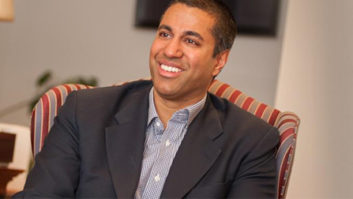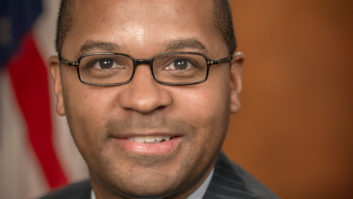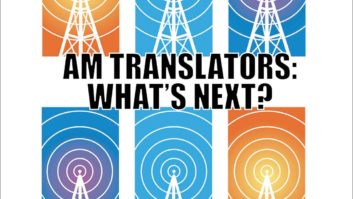
Earlier we reported what NAB President/CEO Gordon Smith said from the podium of the NAB Show in his state of the industry remarks. Now here is the speech of FCC Chairman Tom Wheeler at the convention as prepared for delivery. It was Wheeler’s first appearance at a spring show since taking over the chair. In the photo, Wheeler sits at right, talking with Smith on stage.
Thank you, Senator Smith, for inviting me to be here. I look forward to our one-on-one.
Now, I know what some of you are thinking: Gordon Smith and Tom Wheeler mano-y-mano in Las Vegas…that sounds like an awesome UFC pay-per-view.
Obviously, that’s ridiculous. If Gordon and I were to fight it would be broadcast free, over-the-air.
It’s no secret that NAB has been critical of some of my actions as FCC Chairman. The Broadcasting & Cable cover feature on Gordon entitled “No More Mr. Nice Guy” says it all. Gordon Smith “has his sleeves rolled up for a brawl.” Because of me?!?! Say it ain’t so.
As a former association head, I have a unique appreciation for the job Gordon is doing. I understand that a good enemy is a priceless asset. Although that tactic sure feels different if I’m the enemy – especially when I’m not.
Trust me. I get the skepticism.
Here’s the former head of the cable AND the wireless industry at the NAB Show telling you he’s your friend. That’s as crazy as the former head of the cable and the wireless industry at the NAB Show telling you he’s your friend. There is no more ridiculous metaphor.
Yes, in a previous life, I advocated for cable, and I advocated for wireless, back in the days when both were pretty much in startup mode.
What most people don’t know is that I’ve also advocated for broadcast licensees.
I led the charge during the Obama Transition to delay the DTV transition so that would go as smoothly as it ultimately did. And while spending almost a decade as a VC, I invested in the efforts to bring mobile DTV to life. In other words, I put my money on the future of broadcasting.
All of those previous activities are, however, irrelevant to my responsibilities today.
Today, I have the American people as my client, and the actions we take at the FCC are built around the interests of that client.
I strongly believe that the interests of the American people are served by a vibrant broadcasting industry and include the continuation of broadcasting’s historic role as a principal conveyor of news and entertainment, and especially of its invaluable role as “first informer.”
My purpose today is optimism, not opposition.
I’d like to focus on the opportunity for broadcast licensees in the 21st century and what the FCC can do to facilitate that future.
In particular, I want to focus on three opportunities: the opportunities to provide over-the-top services built around news and information; the opportunities inherent in the Incentive Auction; and the opportunities created as we contemplate a transition to new TV sets using OFDM.
Our mantra at the FCC is “competition, competition, competition.”
We believe that competition is better than regulation at stimulating innovation and protecting consumers. I recognize that the broadcasting industry is subject to competition – more, in fact, today than ever before. And I recognize that more is coming.
But I also believe that broadcasting is positioned to be not only the reluctant object of competition, but the instigator as well. We are at an inflection point where broadcast licensees can move from being the disrupted, to being the disruptor.
I love history and like to think in historical metaphors. Broadcast licensees are no more in the “television” business than a canal company was in the barge business. Your business horizons are greater than your current product.
The canal companies succumbed to the railroads because they failed to define themselves beyond “barges” to see they were in the “transportation” business. (Instead, in fact, they expended their resources trying to get the government to restrict the railroads.)
In a modern example, the cable companies didn’t make that mistake. They redefined themselves from video retransmitters to telecommunications companies.
When I was at NCTA the “T” stood for “Television.”
Today, however, the name has been changed to reflect the industry’s broader focus — the National Cable and Telecommunications Association. We would like to help “television stations” similarly to pivot to become digital “information providers.”
Broadcast licensees have a powerful opportunity to bring the benefits of competition to the new media market. When I look at broadcasting I see the traditional public trust where you received spectrum and in return provided important public benefits – and I don’t see that changing.
But I also hope we can see local broadcast licensees as a growing source of competition in the digital market.
Your content represents far more than the potential for retransmission fees. It can be the basis for a fixed and mobile-delivered cable-like service. You possess the two most important components of a successful digital strategy: compelling content – specifically, the most important content: local content – and the means to promote it. Even better, you can leverage those advantages at only incremental cost.
The hottest thing in the media business today is OTT – Over the Top – content. OTT is content that is owned by someone other than the network operator. Netflix is the classic example. It has seized the opportunity to buy programming from the same studios and networks you buy from, and put it OTT.
A new study by the Pew Research Center, however, points to a way forward for local licensees. That study reports that a third of all Americans watch news videos online.
Broadcast licensees are in the pole position to leverage off that trend to deliver broader OTT services anchored in local news and information.
Many stations today have websites on which they feature their local news content, which they can update 24/7.
You have the opportunity to leverage that content to become broader OTT competitors as the source for local news down to the neighborhood.
For all the wonderful things the Internet has done, one place that it has yet to deliver on its promise is local content. When I was a VC I looked at business plans to plug that gap but did not invest because the cost of developing the content and the cost of promoting it made the plans unsustainable.
You don’t suffer from either of these limitations. News is already a high-margin activity, and your unsold avails are the ultimate promotion vehicle.
The cable companies use their unsold avails to promote their Internet-based businesses – the same opportunity exists for broadcast licensees to promote their Web-based local content. And the cable companies don’t have the reporting boots on the ground that you do.
This is where our policy activities become relevant to creating a new expansive era for broadcast licensees.
We have been spending a lot of time at the FCC working to assure that there is an open Internet. This is directly relevant to the opportunity the digital future presents for you.
Again, those who provide you with content have taken advantage of the open Internet to distribute their content without relation to your service. The open Internet represents the same kind of expansive opportunity for local licensees.
Essential to the open Internet are the concepts that a network provider – and here we are increasingly talking about your cable friends – cannot block lawful content or unfairly target content and other edge providers.
I hope you don’t view the open Internet is something relevant only to a different part of communications.
The open Internet rules should be seen as an Open Sesame for the expansion beyond your local license; to move from the “television” business to the “information” business.
But your window of opportunity won’t stay open forever.
Yahoo is reportedly relying on the open Internet to expand into local TV news. The Wall Street Journal reports they plan to spend $300 million to acquire a company that syndicates news clips from 200 local stations. Yahoo’s strategy is to offer personalized local news content and to sell higher CPM video ads around it.
The telecom companies aren’t hesitating in their pivot either. Both Verizon and AT&T are reportedly exploring new lines of business based on broadcast LTE. Verizon has bought Intel’s media platform and recently paid $1 billion for NFL rights – what does that tell you?
Clearly, Yahoo, AT&T and Verizon are well aware that history is full of businesses that when confronted with technological change clung to their old models – and did not survive.
They all are embracing something new that looks startlingly like your model.
Because we are pro-competition, we hope that broadcast licensees will see this challenge as a call to action. Again, that’s why the open Internet initiative is important.
I’ve heard many broadcasters argue that they haven’t considered a mobile strategy because they would have to pay mobile carriers too much for the carriage. Think open Internet here instead.
While the rules for mobile have been different from those for wired providers, the root concept is openness – including in wireless.
Of course, there is the pesky little matter of how you pay for this kind of pivot. Here, again, the ongoing policy activities of the FCC can be helpful.
Which brings me to the second big opportunity I wanted to highlight – the Incentive Auction.
A few points up front on the Incentive Auction. The FCC is carrying out the mandate of the Congress. The NAB was at the table when Congress created the Incentive Auction. I was not.
As I observed from afar, you lobbied hard and ultimately supported the legislation as enacted. The FCC is simply doing what Congress authorized: creating a market mechanism for spectrum reallocation. There is no conspiracy. Those who want to participate can. Those who choose not to participate, that’s fine as well. You will have the ability to determine for yourself if you want to participate.
We are developing an outreach plan that will include the provision of detailed auction information to help you make your assessments.
Going back to the point about funneling cash into your coffers so you can pay for a pivot to Over-the-Top opportunities, I continue to believe that the auction presents a terrific financial opportunity for broadcasters.
An under-considered and under-appreciated aspect of the Incentive Auction is the idea of spectrum sharing. The pilot project conducted by Los Angeles stations KLCS and KJLA has provided real-world evidence of channel sharing’s technical feasibility.
I’ve been to the station. I have seen its success with my own eyes.
Spectrum sharing will allow you to maintain your existing business while taking home an auction check. It is a once-in-a-lifetime, virtually risk-free opportunity to expand your business model on somebody else’s dime.
Channel sharing will allow you to remain on the air, maintain must-carry status if you are a must-carry station, AND have a new source of capital that doesn’t dilute your ownership. Sounds like a pretty good deal to me.
I caution, however, that the Incentive Auction opportunity is not likely to come again anytime soon. While legally we could hold another auction, realistically I’m not as sure.
Having just done a repacking, to restart the process yet again, I imagine, is something the industry – as well as the government – would find disruptive and unappealing.
The third opportunity I want to talk about is using a new television standard as the entry point to the broadband economy for broadcasting.
I have always been and I remain a proponent of new technological ideas. I have been a part of businesses that seized the new technology to ride to a great future, and I have been a part of businesses that discovered that technology alone does not make a revolution.
When it comes to OFDM technology – popularly referred to as ATSC 3 – the FCC will be ready and responsive when the standard is completed. While ATSC 3 is not backward-compatible with existing televisions (a non-trivial challenge), it is compatible with the Incentive Auction.
Whether the licensee keeps the channel or decides to use the Incentive Auction’s opportunity to share spectrum, the expanded throughput of ATSC 3 will be available when ATSC 3 is finally available.
If it is possible to get a multiple of throughput on spectrum with OFDM, we, as stewards of the spectrum, need to be supportive.
If it is possible to expand competition by offering wireless throughput at or better than the level that will be commonly available at the time of its rollout, we need to welcome the competition.
We just lived through one TV transition; I’ve been there, you’ve been there. We both know the magnitude of that challenge. We should neither shrink from it, nor underestimate its magnitude.
Government and broadcasting will need to work together because it’s going to be a long and heavy lift.
While my remarks have focused on opportunities, let me close briefly with a point about obligations – yours and mine.
As NAB correctly says, broadcast licensees are “licensed to serve.” As to the service part, your long history attests that you are right to take pride in your record. As to the “licensed” part, there are additional obligations that fall both on the industry and on the FCC.
This means that when it comes to broadcast licensees our job is to fulfill the instructions of the Congress to promote competition, diversity, and localism.
That is the root of our recent decision on JSAs and SSAs. Simply put, where sidecar agreements serve the public interest by advancing the goals established by Congress, they are appropriate.
When entanglements between separately owned stations serve as end runs around our local television rules, however, it is appropriate to push the stop button.
Let me be clear, where sidecar agreements are tailored to facilitate statutory values such as a diversity of voices and ownership they will have no problem clearing the FCC.
The waiver process we instituted is sympathetic to efficiency-producing agreements so long as they do not impair competition and ownership diversity. The actions of some, however, adversely affect competition and diversity. They have forced new actions that have the simple goal of enforcing our rules.
But I’m not here to rehash old issues.
My message today is that we want to work with you to focus on the future.
Great opportunities confront and challenge broadcast licensees.
Grasping any of these opportunities calls for entrepreneurial imagination and leadership.
It requires a willingness to think anew and act anew.
Our job at the FCC is to facilitate such innovation.
Your industry has led the way in serving America’s viewers in the past, and we have every confidence that you can do so in the future.
We look forward to working with you as broadcast licensees who have meant so much to this Nation, reach for and define new levels of service for Americans.












